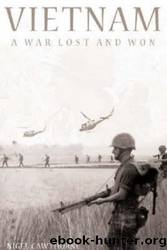Vietnam: A War Lost And Won by Nigel Cawthorne

Author:Nigel Cawthorne
Language: eng
Format: mobi
ISBN: 9781848584143
Publisher: Arcturus Publishing Limited
Published: 2011-07-24T16:00:00+00:00
US Marines at Khe Sanh prepare defences during the siege, 1968.
The base was hit by over 1,000 rounds of incoming fire some days. Any movement above ground attracted the attention of snipers. On 23 February, 29 men from Bravo company under Lieutenant Jacques went out to deal with an NVA mortar position that was pounding the base with uncanny accuracy. They walked straight into a wave of rifle fire and only four of them made it back to the perimeter. The remains of the other 25 lay outside the wire for four weeks before they could be retrieved.
Each morning a tattered Stars and Stripes would be hauled up the flagpole on Hill 881S to show that the Marines still occupied it. Captain Dabney ordered his men to stand to attention until the last note of the bugle had sounded, despite being in the enemy line of fire. Some days the battle became so intense that men had to stand in line to piss on the mortar tubes to keep them cool. On Hill 881, the casualty rate was 50 per cent and the men got down to a one-quart canteen of water a day. Marines were constantly in danger of being shot by snipers and medevac helicopters carrying the wounded were brought down. However, only small-scale attacks were launched against the base itself: Westmoreland never got the full-scale battle that he craved.
Slowly, as the weather improved, more supplies got through and the men on Hill 881S could see well enough to call down accurate air strikes on the NVA. They knew they were winning when, on 1 April, two naked NVA soldiers ran up to their positions in broad daylight, asking to surrender. One was shot in the back by his own troops; Marines crawled out under heavy fire to retrieve the other one. Back in the trench, he seemed calm, until a Marine jet passed overhead, when he threw himself into the corner of the trench quivering uncontrollably. The air strikes were plainly taking their toll.
Although the Marines held on to the high ground overlooking Khe Sanh, which they had taken from the NVA in April and May 1967, the Special Forces camp at Lang Vei, eight miles southwest of Khe Sanh down Route 9, was overrun. It had been manned by twenty-two Green Berets and 400 CIDGs when, on 7 February, NVA tanks rolled in across the wire, the first time the North Vietnamese had used armour. The defenders stood no chance. The camp had been established as a base for guerrilla operations against the Ho Chi Minh trail across the border in Laos, not as a defensive position. There was a rudimentary defence plan, though. The commander Captain Frank C. Willoughby could call in artillery support from Khe Sanh, Camp Carroll and the Rockpile, whose guns were pre-registered on positions around the camp. Forward Air Controllers could call in USAF and Marine ground-attack aeroplanes and, if all else failed, Colonel Lownds was to send two rifle companies by helicopter or by foot to Lang Vei.
Download
This site does not store any files on its server. We only index and link to content provided by other sites. Please contact the content providers to delete copyright contents if any and email us, we'll remove relevant links or contents immediately.
| Africa | Americas |
| Arctic & Antarctica | Asia |
| Australia & Oceania | Europe |
| Middle East | Russia |
| United States | World |
| Ancient Civilizations | Military |
| Historical Study & Educational Resources |
Wabi sabi by Kempton Beth(721)
Mr. Selden's Map of China by Timothy Brook(601)
Heroic Hindu Resistance To Muslim Invaders (636 AD to 1206 AD) by Sita Ram Goel(573)
Akbar: The Great Mughal by Ira Mukhoty(544)
The Meaning of India by Raja Rao(537)
Vedic Physics: Scientific Origin of Hinduism by Raja Ram Mohan Roy(536)
Banaras by Diana L. Eck(527)
Philippines--Culture Smart! by Culture Smart!(503)
Mao's Great Famine: The History of China's Most Devastating Catastrophe, 1958-1962 by Frank Dikötter(501)
Food of India by unknow(497)
China Unbound by Joanna Chiu(486)
How to Be a Modern Samurai by Antony Cummins(474)
India--Culture Smart! by Becky Stephen(473)
A History of Japan by R.H.P. Mason & J.G. Caiger(468)
Insurgency and Counterinsurgency by Jeremy Black(465)
North of South by Shiva Naipaul(462)
The Genius of China: 3,000 Years of Science, Discovery, and Invention by Robert Temple(446)
Kim Jong Un and the Bomb by Ankit Panda(431)
The Digital Silk Road by Jonathan E. Hillman(423)
